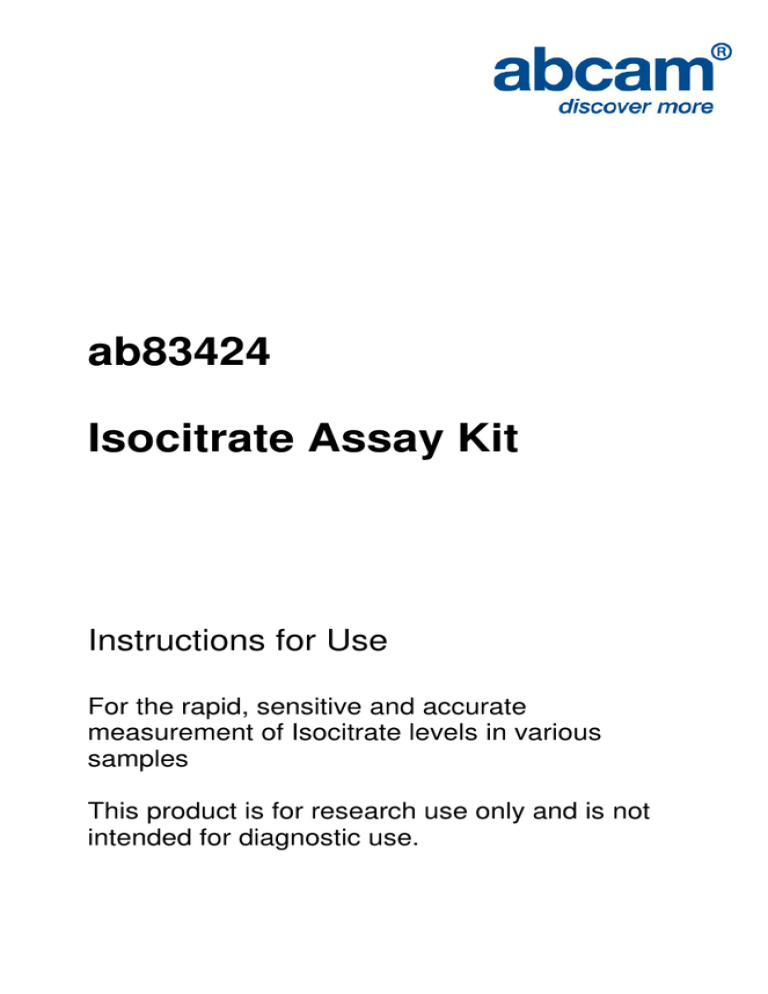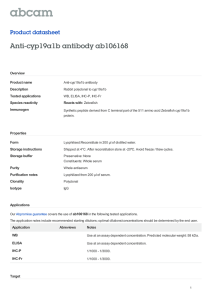
ab83424
Isocitrate Assay Kit
Instructions for Use
For the rapid, sensitive and accurate
measurement of Isocitrate levels in various
samples
This product is for research use only and is not
intended for diagnostic use.
1
Table of Contents
1.
Overview
3
2.
Protocol Summary
4
3.
Components and Storage
5
4.
Assay Protocol
7
5.
Data Analysis
9
6.
Troubleshooting
11
2
1. Overview
Isocitric
acid
(HOOC-CHOH-CH
(-COOH)-CH2-COOH)
is
an
intermediate of the Krebs TCA cycle, positioned between citrate and
α-keto-glutarate. It is the branch point from which the glyoxylate
shunt operates in plants and lower organisms. Isocitrate is found in
substantial concentrations in many fruits and vegetables as well as
in foods produced from these raw materials. In the TCA cycle,
isocitrate
is
oxidized by isocitrate dehydrogenase (IDH)
to
α-ketoglutarate with the generation of NAD(P)H. Loss of NAD-IDH
has been implicated as a potential causative factor in retinitis
pigmentosa.
Abcam's Isocitrate Assay Kit provides a simple, sensitive and rapid
means of quantifying isocitrate in a variety of samples. In the assay,
isocitrate is oxidized with the generation of NADPH which converts a
nearly colorless probe to an intensely colored species with a λmax of
450nm. The Isocitrate Assay Kit can detect 1 to 20 nmoles
(~0.2-5 µg) of isocitrate.
3
2. Protocol Summary
Sample Preparation
Standard Curve Preparation
Prepare and Add Reaction Mix
Measure Optical Density
4
3. Components and Storage
A. Kit Components
Item
Quantity
Isocitrate Assay Buffer
25 mL
Isocitrate Enzyme Mix
200 µL
Substrate Mix (Lyophilized)
1 vial
Isocitrate Standard (Lyophilized)
1 vial
* Store kit at -20°C, protect from light. Warm Isocitrate Assay Buffer
to room temperature before use. Briefly centrifuge all small vials prior
to opening. Read the entire protocol before performing the assay.
ISOCITRATE ENZYME MIX: Ready to use as supplied. Aliquot into
portions and store at -20°C. Use within two months.
SUBSTRATE MIX: Add 220 µl dH2O and dissolve. Stable for 2
months at 4°C.
ISOCITRATE STANDARD: Dissolve in 100 µl dH2O to generate
100 mM (100 nmol/µl) Isocitrate Standard solution. Keep cold while
in use. Store at -20°C.
5
B. Additional Materials Required
•
Microcentrifuge
•
Pipettes and pipette tips
•
Colorimetric microplate reader
•
96 well plate
•
Orbital shaker
6
4. Assay Protocol
1. Sample Preparations:
6)
a. Tissue or cell samples: Tissue (20 mg) or cells (2 x 10 should
be rapidly homogenized with 100 µl Isocitrate Assay Buffer.
Centrifuge at 15,000 g for 10 min to remove cell debris. Add 1-50 µl
samples into duplicate wells of a 96-well plate and bring volume to
50 µl with Assay Buffer.
Note:
Enzymes in samples may interfere with the assay. We suggest
deproteinizing your sample using 10 kDa molecular weight cut off
spin columns (ab93349); alternatively use a perchloric acid/KOH
protocol as follows:
a) Tissue samples (20-1000 mg) should be frozen rapidly (liquid N2
or methanol/dry ice), weighed and pulverized.
b) Add 2 µl 1N perchloric acid/mg per sample. KEEP COLD!
c) Homogenize or sonicate thoroughly. Spin homogenate at
10,000 x g for 5-10 minutes.
d) Neutralize supernatant with 3M KHCO3, adding repeated 1 µl
aliquots/10 µl supernate while vortexing. Add until bubble
evolution ceases (2-5 aliquots). Put on ice for 5 minutes.
e) Check pH (using 1 µl) is ~6-8. Spin 2 minutes at 10,000 x g to
pellet KClO4.
f) Add 10 µl sample into duplicate wells (Sample and Background)
of a 96-well plate; bring volume to 50 µl with Assay Buffer.
7
b. Food or beverage samples: Most beverages can be used
directly in the assay, with appropriate dilution. In general, samples
should be spin filtered through a 10 kDa MWCO filter such as
ab93349. This will remove inhibitory substances, protein and most
color. Solids should be processed by homogenizing 20 mg with
500 µl distilled water, with mild heating for 30 min, then centrifuge
15,000 x g, 10 min. Take supernatant, spin filter and dilute
appropriately for the assay.
For all samples, we suggest testing several doses of your samples to
ensure readings are within the standard curve range.
2. Standard Curve Preparation:
Dilute Isocitrate Standard to 2 nmol/µl by adding 20 µl of the
Standard to 980 µl of dH2O, mix well. Add 0, 2, 4, 6, 8, 10 µl into a
series of wells on a 96 well plate. Adjust volume to 50 µl/well with
Assay Buffer to generate 0, 4, 8, 12, 16, 20 nmol/well of the
Standard.
3. Reaction Mix: Mix enough reagent for the number of samples
and standards to be performed: For each well, prepare a total 50 µl
Reaction Mix containing:
Isocitrate Assay Buffer
46 µl
Isocitrate Enzyme Mix
2 µl *
Substrate Mix
2 µl
8
* Note: NADH and NADPH can generate significant background in
some instances. If interfering levels of these are suspected of being
in the sample, a background control can be performed by running a
parallel sample with the Isocitrate Enzyme Mix being omitted.
4. Add 50 µl of Reaction Mix to each well containing the Isocitrate
Standard and test and background control samples. Incubate for 30
min at 37°C, protect from light.
5. Measurement: Measure the OD at 450 nm with a microplate
reader.
5. Data Analysis
Correct background by subtracting the value of the zero Isocitrate
standard from all readings. The background reading can be
significant and must be subtracted.
Plot the standard curve. Then apply the corrected sample readings
to the standard curve to get Isocitrate amount in the sample wells.
The Isocitrate concentrations in the test samples:
Concentration = Ay / Sv (nmol/µl; or µmol/ml; or mM)
9
Where:
Ay is the amount of Isocitrate (nmol) in your sample from the
standard curve.
Sv is the sample volume (µl) added to the sample well.
Isocitrate molecular weight: 192.12 g/mol
Isocitrate standard curve generated using this kit protocol.
10
6. Troubleshooting
Problem
Reason
Solution
Assay not
working
Assay buffer at
wrong temperature
Assay buffer must not be chilled
- needs to be at RT
Protocol step missed
Plate read at
incorrect wavelength
Unsuitable microtiter
plate for assay
Unexpected
results
Re-read and follow the protocol
exactly
Ensure you are using
appropriate reader and filter
settings (refer to datasheet)
Fluorescence: Black plates
(clear bottoms);
Luminescence: White plates;
Colorimetry: Clear plates.
If critical, datasheet will indicate
whether to use flat- or U-shaped
wells
Measured at wrong
wavelength
Use appropriate reader and filter
settings described in datasheet
Samples contain
impeding substances
Unsuitable sample
type
Sample readings are
outside linear range
Troubleshoot and also consider
deproteinizing samples
Use recommended samples
types as listed on the datasheet
Concentrate/ dilute samples to
be in linear range
11
Samples
with
inconsistent
readings
Unsuitable sample
type
Samples prepared in
the wrong buffer
Samples not
deproteinized (if
indicated on
datasheet)
Cell/ tissue samples
not sufficiently
homogenized
Too many freezethaw cycles
Samples contain
impeding substances
Samples are too old
or incorrectly stored
Lower/
Higher
readings in
samples
and
standards
Not fully thawed kit
components
Out-of-date kit or
incorrectly stored
reagents
Reagents sitting for
extended periods on
ice
Incorrect incubation
time/ temperature
Incorrect amounts
used
Refer to datasheet for details
about incompatible samples
Use the assay buffer provided
(or refer to datasheet for
instructions)
Use the 10kDa spin column
(ab93349)
Increase sonication time/
number of strokes with the
Dounce homogenizer
Aliquot samples to reduce the
number of freeze-thaw cycles
Troubleshoot and also consider
deproteinizing samples
Use freshly made samples and
store at recommended
temperature until use
Wait for components to thaw
completely and gently mix prior
use
Always check expiry date and
store kit components as
recommended on the datasheet
Try to prepare a fresh reaction
mix prior to each use
Refer to datasheet for
recommended incubation time
and/ or temperature
Check pipette is calibrated
correctly (always use smallest
volume pipette that can pipette
entire volume)
12
Problem
Reason
Solution
Standard
curve is not
linear
Not fully thawed kit
components
Wait for components to thaw
completely and gently mix prior
use
Pipetting errors when
setting up the
standard curve
Incorrect pipetting
when preparing the
reaction mix
Air bubbles in wells
Concentration of
standard stock
incorrect
Errors in standard
curve calculations
Use of other
reagents than those
provided with the kit
Try not to pipette too small
volumes
Always prepare a master mix
Air bubbles will interfere with
readings; try to avoid producing
air bubbles and always remove
bubbles prior to reading plates
Recheck datasheet for
recommended concentrations of
standard stocks
Refer to datasheet and re-check
the calculations
Use fresh components from the
same kit
For further technical questions please do not hesitate to
contact us by email (technical@abcam.com) or phone (select
“contact us” on www.abcam.com for the phone number for
your region).
13
14
UK, EU and ROW
Email: technical@abcam.com
Tel: +44 (0)1223 696000
www.abcam.com
US, Canada and Latin America
Email: us.technical@abcam.com
Tel: 888-77-ABCAM (22226)
www.abcam.com
China and Asia Pacific
Email: hk.technical@abcam.com
Tel: 108008523689 (中國聯通)
www.abcam.cn
Japan
Email: technical@abcam.co.jp
Tel: +81-(0)3-6231-0940
www.abcam.co.jp
Copyright © 2012 Abcam, All Rights Reserved. The Abcam logo is a registered trademark.
15
All information / detail is correct at time of going to print.

